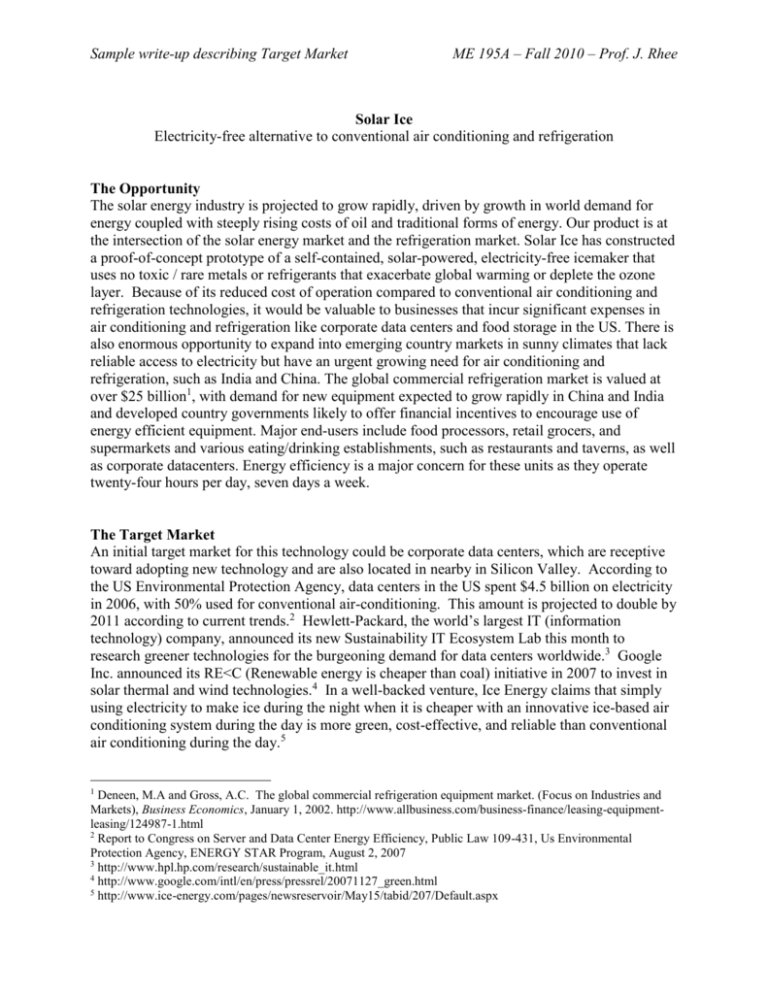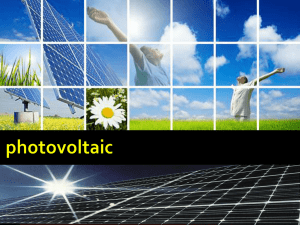Solar Ice target mar..
advertisement

Sample write-up describing Target Market ME 195A – Fall 2010 – Prof. J. Rhee Solar Ice Electricity-free alternative to conventional air conditioning and refrigeration The Opportunity The solar energy industry is projected to grow rapidly, driven by growth in world demand for energy coupled with steeply rising costs of oil and traditional forms of energy. Our product is at the intersection of the solar energy market and the refrigeration market. Solar Ice has constructed a proof-of-concept prototype of a self-contained, solar-powered, electricity-free icemaker that uses no toxic / rare metals or refrigerants that exacerbate global warming or deplete the ozone layer. Because of its reduced cost of operation compared to conventional air conditioning and refrigeration technologies, it would be valuable to businesses that incur significant expenses in air conditioning and refrigeration like corporate data centers and food storage in the US. There is also enormous opportunity to expand into emerging country markets in sunny climates that lack reliable access to electricity but have an urgent growing need for air conditioning and refrigeration, such as India and China. The global commercial refrigeration market is valued at over $25 billion1, with demand for new equipment expected to grow rapidly in China and India and developed country governments likely to offer financial incentives to encourage use of energy efficient equipment. Major end-users include food processors, retail grocers, and supermarkets and various eating/drinking establishments, such as restaurants and taverns, as well as corporate datacenters. Energy efficiency is a major concern for these units as they operate twenty-four hours per day, seven days a week. The Target Market An initial target market for this technology could be corporate data centers, which are receptive toward adopting new technology and are also located in nearby in Silicon Valley. According to the US Environmental Protection Agency, data centers in the US spent $4.5 billion on electricity in 2006, with 50% used for conventional air-conditioning. This amount is projected to double by 2011 according to current trends.2 Hewlett-Packard, the world’s largest IT (information technology) company, announced its new Sustainability IT Ecosystem Lab this month to research greener technologies for the burgeoning demand for data centers worldwide.3 Google Inc. announced its RE<C (Renewable energy is cheaper than coal) initiative in 2007 to invest in solar thermal and wind technologies.4 In a well-backed venture, Ice Energy claims that simply using electricity to make ice during the night when it is cheaper with an innovative ice-based air conditioning system during the day is more green, cost-effective, and reliable than conventional air conditioning during the day.5 1 Deneen, M.A and Gross, A.C. The global commercial refrigeration equipment market. (Focus on Industries and Markets), Business Economics, January 1, 2002. http://www.allbusiness.com/business-finance/leasing-equipmentleasing/124987-1.html 2 Report to Congress on Server and Data Center Energy Efficiency, Public Law 109-431, Us Environmental Protection Agency, ENERGY STAR Program, August 2, 2007 3 http://www.hpl.hp.com/research/sustainable_it.html 4 http://www.google.com/intl/en/press/pressrel/20071127_green.html 5 http://www.ice-energy.com/pages/newsreservoir/May15/tabid/207/Default.aspx Sample write-up describing Target Market ME 195A – Fall 2010 – Prof. J. Rhee Given these trends, our initial customers would be data centers owners, e.g. Hewlett-Packard, Google, Yahoo, IBM, eBay, and the US government. A solar powered icemaker in conjunction with an ice-based air conditioning system would practically eliminate electricity required to cool data centers, except for the minimal amount needed to run fans and valves during the day. Solar Ice would develop a product that could retrofit existing infrastructure for conventional air conditioning. Ice Energy claims a 9-year payback period (2-years with incentives) with their energy-consuming technology, and it is the expectation that ours would be significantly shorter. Most of the efforts to reduce electricity consumption by data centers are through energy conservation. Up to 25% of the energy required for air conditioning can be saved by consolidating servers, judiciously routing cooled air, and using energy efficient components. Emerging competitive alternatives include solar powered absorption refrigeration, and refrigeration powered by photovoltaic cells. In addition, two similar solar icemakers exist, primarily targeted for third world markets.6,7 The existing products are not targeted or scaled for data centers. Patents related to these devices were granted between 1986 and 1990, and typically last 20 years.8,9,10,11,12 Upon penetration of the initial market, we could expand our reach to markets in sunny climates that lack reliable access to electricity but have an urgent growing need for air conditioning and refrigeration. These markets could greatly benefit from this product to refrigerate vaccines and food, or cool buildings. For example, 70% of India’s inhabitants (770 million out of 1.12 billion people) live in rural areas, and only 45% of households in these areas have access to electricity. Furthermore, over 50% of deaths in India are due to heat related causes such as defective vaccines, spoiled food, and heat waves. China would be another region to target with its burgeoning need for power. 6 Vanek, J, Green, M, & Vanek, S (1996). A Solar Ammonia Absorption Icemaker. Home Power. 53, 20-23 Erickson, C., 1997, “Intermittent solar ammonia absorption cycle; design, operation, and optimal performance,” proceedings of the International Solar Energy Conference, April 27-30, pp. 291-295 8 Erickson, D., (1990) US Patent No. 4966014, Washington D.C.: US Patent and Trademark Office 9 Erickson, D., (1988) US Patent No. 4744224, Washington D.C.: US Patent and Trademark Office 10 Erickson, D., (1993) US Patent No. 5272891, Washington D.C.: US Patent and Trademark Office 11 Tchernev, (1986) US Patent No. 4584842, Washington D.C.: US Patent and Trademark Office 12 Friberg, S., Korsgarrd, P., and Worsoe, P., (1986) US Patent No. 4586345, Washington D.C.: US Patent and Trademark Office 7






